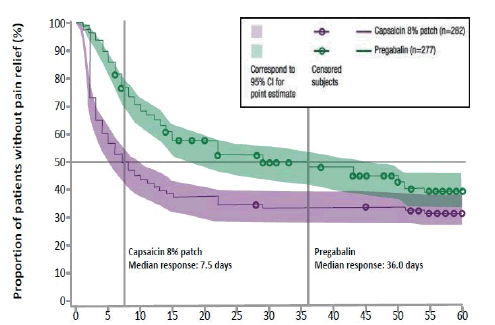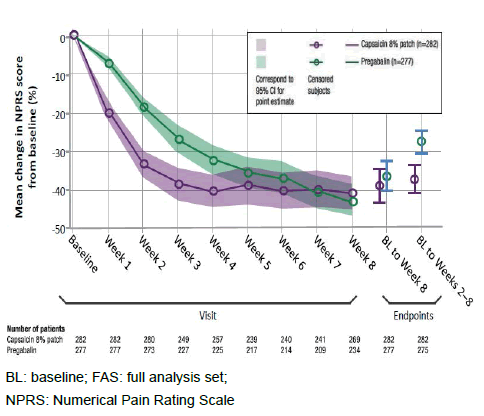Case Report Open Access
Capsaicin 8% Patch Compared with Pregabalin in the Treatment of Nondiabetic Peripheral Neuropathic Pain: Elevate Trial
| Antonio Alcántara Montero* | |
| Chronic Pain Unit,José María Álvarez Health Center. Don Benito (Badajoz), Spain. Member of the Working Group Pain SEMERGEN, Spain | |
| Corresponding Author : | Antonio Alcántara Montero Chronic Pain Unit. José María Álvarez Health Center Don Benito (Badajoz) 06400 Don Benito (Badajoz), Spain Tel: 34 650 732 962 E-mail: a.alcantara.montero@hotmail.com |
| Received January 07, 2016; Accepted January 19, 2016; Published January 22, 2016 | |
| Citation: Alcántara A (2016) Capsaicin 8% Patch Compared with Pregabalin in the Treatment of Nondiabetic Peripheral Neuropathic Pain: Elevate Trial. J Pain Relief 5:227. doi:10.4172/2187-0846.1000227 | |
| Copyright: © 2016 Alcántara A. This is an open-access article distributed under the terms of the Creative Commons Attribution License, which permits unrestricted use, distribution, and reproduction in any medium, provided the original author and source are credited. | |
Visit for more related articles at Journal of Pain & Relief
Abstract
Conventional treatments for peripheral neuropathic pain may be restricted by factors such as systemic side effects, interactions with other drugs, the slow onset of action, the need for dose adjustments and multiple daily doses. Recently it has been published in the European Journal of Pain a simultaneous non-inferiority study comparing patch capsaicin 8% with pregabalin (flexible dose optimized) in adult patients with nondiabetic peripheral neuropathic pain. According to this study, topical treatment with capsaicin patch 8% was not inferior to pregabalin. This means that the patch capsaicin 8% could be another treatment option for patients with Nondiabetic peripheral neuropathic pain, especially those who are very sensitive to the side effects of systemic medications or for those not wishing oral drug treatment daily.
| Keywords |
| Capsaicin patch; Pregabalin; Nondiabetic peripheral neuropathic pain; Postherpetic neuralgia |
| Introduction |
| Neuropathic pain arises as a direct consequence of a lesion or disease affecting the somatosensory system (e.g. diabetes mellitus, herpes zoster infection, HIV infection, chemotherapy or surgery) and can be classified as peripheral or central depending on where the lesion/disease is situated [1]. Diagnosis is suggested by the presence of allodynia, dysaesthesia (e.g., burning, tingling) and signs of nerve injury [2]. |
| Neuropathic pain is very challenging to manage because of the heterogeneity of aetiologies, symptoms and underlying mechanisms [3,4]. Conventional oral therapies have been limited by negative factors such as systemic side effects, drug-drug interactions, slow onset of action, the need for titration, multiple daily dosing and the potential risk of addiction, dependence, withdrawal symptoms and abuse [3,5]. Furthermore, most topical treatments require frequent applications (daily for the lidocaine 5% patch and up to four times a day for the capsaicin creams) [6,7]. |
| The capsaicin 8% patch is an adhesive patch containing a high concentration (8% w/w) of synthetic capsaicin, a selective agonist of transient receptor potential vanilloid 1 channel. It is approved for treatment of peripheral neuropathic pain in adults either alone or in combination with other medicinal products for pain in the EU; it is only approved to treat postherpetic neuralgia (PHN) in the USA [8]. |
| The capsaicin 8% patch was generally well tolerated by patients with peripheral neuropathic pain, with most treatment-emergent adverse events being of mild to moderate intensity and relatively few patients discontinuing treatment because of adverse events. The most frequently reported adverse events in clinical trials were transient application-site reactions. Most patients who required intervention for treatmentrelated pain were adequately managed with local cooling and/or oral medications [9]. |
| Place of capsaicin 8% patch in the management of peripheral neuropathic Pain |
| Current strategies for the treatment of neuropathic pain include systemic pharmacotherapy (e.g. tricyclic antidepressants, serotonin noradrenaline reuptake inhibitors, anticonvulsants and opioids) or topical analgesics (e.g. lidocaine 5% plaster, capsaicin 8% patch) [4,10-13]. Tricyclic antidepressants, gabapentin, pregabalin or lidocaine 5% plasters (particularly in elderly patients) are often recommended as first-line treatments [4,10-13]. Second-line treatments generally include tramadol [4,10-12], and in some cases, nortriptyline, imipramine or duloxetina [10-12]. Strong opioids, other antiepileptics, other antidepressants, cannabinoids, N-methyl-D-aspartate receptor antagonists, memantine, mexiletine and topical low-concentration capsaicin cream are often third-line options [4,10-13]. |
| Finnerup et al. [14]. have proposed that the NeuPSIG guidelines [4] should be revised following the results of their systematic review and meta-analysis. They determined that tricyclic antidepressants, pregabalin, gabapentina (also extended-release), enacarbil and duloxetine should be recommended as first-line treatments because of strong GRADE classifications [14]. Capsaicin 8% patches are recommended as second-line options (weak GRADE classification) due to low effect sizes, training requirement and a current lack of published data on changes in sensation with long-term use [14]. The lidocaine 5% plaster (currently recommended as a first-line therapy) and tramadol were also recommended as second-line options due to lower tolerability (tramadol) or weak quality of evidence (lidocaine) [14]. Strong opioids and botulinum toxin A should be recommended as third-line options [14]. |
| Capsaicin 8% patch compared with pregabalin |
| The efficacy of the capsaicin 8% patch compared with pregabalin was assessed in a multicentre, open-label trial in patients with nondiabetic peripheral neuropathic pain in the ELEVATE trial [15]. |
| Adults with a mean Numeric Pain Rating Scale (NPRS) score ≥4 over at least four consecutive days and a baseline diagnosis of PHN (pain persisting ≥6 months since shingles vesicle crusting), peripheral nerve injury (post-surgical or post-traumatic neuropathic pain persisting for ≥3 months) or nondiabetic painful peripheral polyneuropathy (pain persisting for ≥3 months) were included. Patients with HIV-associated neuropathy (HIV-AN) were excluded [15]. |
| Following the screening period, patients were randomized to receive the capsaicin 8% patch (n=282) or oral pregabalin (n=277). The capsaicin 8% patch (up to four patches) was given as a single 30-min application to the feet or as a single 60-min application to any other part of the body. Oral pregabalin was initiated at 75 mg/day and was increased by 75 mg every 3-4 days, up to the highest tolerated dose or 600 mg/day over the first 4 weeks (one down-titration was allowed). From weeks 4-8, patients remained on an optimised pregabalin dosage of 150-600 mg/day as two or three divided doses. Noninferiority was achieved if the two-sided 95% confidence interval (CI) for the odds ratio (OR) of the capsaicin patch versus pregabalin was > 0.693 in both the full analysis set (FAS) and per protocol set (PPS) (Figure 1) [15]. |
| The capsaicin 8% patch was noninferior to an optimized dose of oral pregabalin in relieving pain in patients with moderate-to-severe peripheral neuropathic pain. The proportion of patients who achieved a ≥30% decrease in the average NPRS score from baseline to week 8 (primary endpoint) was 55.7% in the capsaicin 8% patch group compared with 54.5% in the pregabalin group. The between-group difference (capsaicin 8% patch - pregabalin) was 1.2% (OR 1.03; 95%CI 0.71-1.49) in the FAS analysis and 0.3% (OR 1.03; 95% CI 0.70-1.52) in the PPS analysis. The median time to pain relief (where 50% of subjects had a 30% reduction in average daily NPRS score) was 7.5 days in capsaicin 8% patch recipients compared with 36.0 days in pregabalin recipients (adjusted hazard ratio 1.68; 95% CI 1.35-2.08; p<0.0001). Mean NPRS scores were reduced by 37.1 and 27.5% from baseline to between weeks 2-8 in the capsaicin 8% patch group and the pregabalin group, respectively (no significant between-group difference) (Figure 2) [15]. |
| According to a prespecified subgroup analysis, the proportion of capsaicin 8% patch recipients versus pregabalin recipients achieving a ≥30% decrease in the average NPRS score was 53.4 vs. 40.9% (treatment difference +12.5%; 95% CI 1.0-24.1) in patients with peripheral nerve injury (n=283), 71.4 vs. 76.7% (-5.3%; 95% CI -20.1 to 9.5) in patients with PHN (n=136) and 46.6 vs. 58.2% (-11.6%; 95% CI -28.1 to 4.8) in patients with non-diabetic painful peripheral polyneuropathy (n=140). Of note, ELEVATE was not adequately powered for subgroup analyses [15]. |
| Capsaicin 8% patch treatment significantly improved mean treatment satisfaction scores at week 8, as assessed by the Treatment Satisfaction Questionnaire for Medication scale, for patient perception of effectiveness (59.1 vs. 54.8; treatment difference 4.3; 95% CI 0.4-8.1), side effects (95.3 vs. 74.1, treatment difference 21.2; 95% CI 17.5-24.9) and global satisfaction (59.6 vs. 52.9; treatment difference 6.7; 95% CI 2.3-11.2) compared with pregabalin treatment; there were no betweengroup differences in convenience score (71.8 vs. 72.8) [15]. |
| In summary, the capsaicin 8% patch was shown to be noninferior to oral pregabalin in nondiabetic adult patients with a variety of types of peripheral neuropathic pain. Importantly, the time to onset of pain relief was significantly shorter in the capsaicin than the pregabalin group. As patients with HIV were excluded, the comparative efficacy of capsaicin versus pregabalin in patients with HIV-AN is unknown. |
| References |
References
- Treede RD, Jensen TS, Campbell JN, Cruccu G, Dostrovsky JO, et al. (2008) Neuropathicpain: redefinition and a gradingsystemforclinical and researchpurposes.Neurology 70: 1630-1635.
- Haanpää M, Attal N, Backonja M, Baron R, Bennett M, et al. (2011) NeuPSIGguidelinesonneuropathicpainassessment.Pain 152: 14-27.
- Dworkin RH, O'Connor AB, Audette J, Baron R, Gourlay GK, et al. (2010) Recommendationsforthepharmacologicalmanagement of neuropathicpain: anoverview and literatureupdate.Mayo Clin Proc 85: S3-14.
- Dworkin RH, O'Connor AB, Backonja M, Farrar JT, Finnerup NB, et al. (2007) Pharmacologicmanagement of neuropathicpain: evidence-basedrecommendations.Pain 132: 237-251.
- Gahr M, Freudenmann RW, Kölle MA, Schönfeldt-Lecuona C (2015) Frombenzodiazepinetopregabalindependence: Differentagents, similar problems.Indian J Psychiatry 57: 111-112.
- Haanpää M, Treede RD (2012) Capsaicinforneuropathicpain: linkingtraditional medicine and molecular biology.EurNeurol 68: 264-275.
- Garnock-Jones KP, Keating GM (2009) Lidocaine 5% medicatedplaster: a review of its use in postherpetic neuralgia .Drugs 69: 2149-2165.
- AstellasPharmaEurope BV (2016) Qutenza®: summary of productcharacteristics.
- Peppin JF, Majors K, Webster LR, Simpson DM, Tobias JK, et al. (2011) Tolerability of NGX-4010, a capsaicin 8% patchforperipheralneuropathicpain.J Pain Res 4: 385-392.
- Attal N, Cruccu G, Baron R, Haanpää M, Hansson P, et al. (2010) EFNS guidelinesonthepharmacologicaltreatment of neuropathicpain: 2010 revision.Eur J Neurol 17: 1113-1113.
- NationalInstituteforHealth and CareExellence (NICE) (2013) Neuropathicpain—pharmacologicalmanagement: thepharmacologicalmanagement of neuropathicpain in adults in non-specialistsettings
- Scottish IntercollegiateGuidelines Network (2013)The Scottish IntercollegiateGuidelines Network (SIGN) guideline 136: management of chronicpain.
- Moulin D, Boulanger A, Clark AJ, Clarke H, Dao T, et al. (2014) Pharmacologicalmanagement of chronicneuropathicpain: revisedconsensusstatementfromthe Canadian PainSociety.Pain Res Manag 19: 328-335.
- Finnerup NB, Attal N, Haroutounian S, McNicol E, Baron R, et al. (2015) Pharmacotherapyforneuropathicpain in adults: a systematicreview and meta-analysis.LancetNeurol 14: 162-173.
- Haanpää M, Cruccu G, Nurmikko TJ, McBride WT, DocuAxelarad A, et al. (2016) Capsaicin 8% patch versus oral pregabalin in patientswithperipheralneuropathicpain.Eur J Pain 20: 316-328.
Figures at a glance
 |
 |
| Figure 1 | Figure 2 |
Relevant Topics
- Acupuncture
- Acute Pain
- Analgesics
- Anesthesia
- Arthroscopy
- Chronic Back Pain
- Chronic Pain
- Hypnosis
- Low Back Pain
- Meditation
- Musculoskeletal pain
- Natural Pain Relievers
- Nociceptive Pain
- Opioid
- Orthopedics
- Pain and Mental Health
- Pain killer drugs
- Pain Mechanisms and Pathophysiology
- Pain Medication
- Pain Medicine
- Pain Relief and Traditional Medicine
- Pain Sensation
- Pain Tolerance
- Post-Operative Pain
- Reaction to Pain
Recommended Journals
Article Tools
Article Usage
- Total views: 10485
- [From(publication date):
January-2016 - Jul 11, 2025] - Breakdown by view type
- HTML page views : 9609
- PDF downloads : 876
